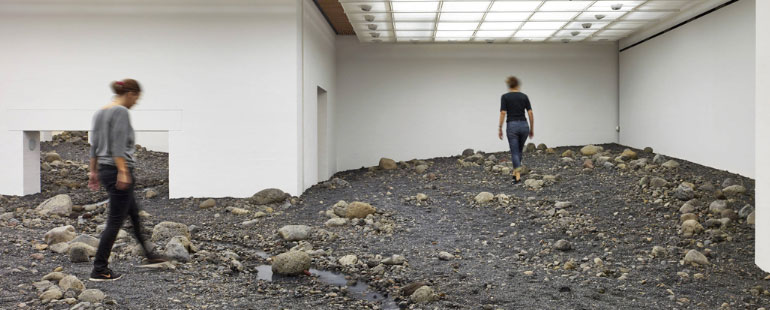Festo creates robots inspired by sea creatures, land animals, and flying insects. Some of their inventions are BionicKangaroo, BionicOpter, AquaJelly, SmartBird, AquaPenguin, and Aqua_Ray.
See the full range of Festo's bionic robots.

Riverbed, 2014
Riverbed is a site-specific landscape designed for Denmark’s Louisiana Museum of Modern Art. Eliasson combines rocks, soil, and water to simulate a riverbed within the museum’s South Wing. The project encourages exploration of the space and questions the divisions between natural and human-made, outside and inside.

Island for Weeds, 2003
Starling’s installation examines the categories of “native” and “invasive” plant species. The weed in his installation is a rhododendron, a plant imported to Scotland from Spain in the eighteenth century. After a long history in Scotland, the plant is now considered an invasive species and is often removed from the environment.
“Starling wanted to take the rhododendron….back to its native Spain…. With his remigration project, Starling raises questions. What makes a species a weed? How (un)natural is it that this rhododendron feels so safe at home in Scotland? Why does this plant belong to Spain but is seen as an alien, an immigrant, in Scotland? How many generations does it take before you can call a species a native species?”1 Often a plant is labeled “invasive” when it no longer meets our needs — many non-native plants that fill our plates or decorate our gardens are rarely described as “invasive” species.
See the Yes Naturally exhibit.
1Yes, Naturally: How Art Saves the World, (Rotterdam, NL: Nai010, 2013), 63.
“Commingling electronics, kinetics, sound, insects, worms, plants and pixels to create art about the relationship between technology and our changing concepts of nature and self.”1
Farm Fountain, 2008
“This project is an experiment in local, sustainable agriculture and recycling.”
Created with Ken Renaldo, Farm Fountain imagines an alternative to contemporary agricultural practices. Tilapia fish swim in the installation’s aquarium base. The fish’s waste feeds plants that hang from the top of the installation. The project also addresses human needs: “The work produces an indoor healthy environment that also provides oxygen and light to the humans working and moving through the space.”1
Museum for Insects
“An insect-sized museum that features artwork specifically created for house crickets. Inside, crickets can interact with hands-on/legs-on exhibits, enjoy food and drink from the café and experience live humans, both through a picture window and through a videophone chat that connects the Museum for Insects to the humans visiting the Peabody Essex Museum.”3
See Young’s website.
1 Amy Youngs, hypernatural.com
2 Fan Di’an and Zhang Ga, eds., Translife: International Triennial of New Media Art, (Liverpool, U.K.: Liverpool University Press, 2013), 245.
3 Museum for Insects